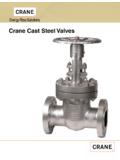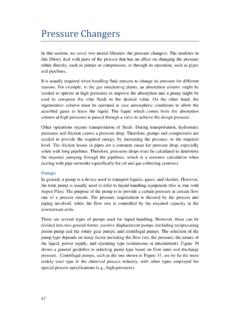Transcription of Assessing heat exchanger performance data using ...
1 MultiCraft International Journal of engineering , Science and Technology Vol. 3, No. 8, 2011, pp. 1-12 INTERNATIONAL JOURNAL OF engineering , SCIENCE AND TECHNOLOGY 2011 MultiCraft Limited. All rights reserved Assessing heat exchanger performance data using temperature measurement uncertainty Tatara1*, Lupia2 1*Department of Technology, Northern Illinois University, USA 2 CSI Technologies, Inc., Elgin, Illinois, USA *Corresponding Author: e-mail: Tel +1-815-753-1130, Fax.+1-815-753-3702 Abstract To ensure operation of heat exchangers, the goal is to verify that the exchanger is performing, or will perform, at its design. This is especially relevant to coolers that typically operate at heat loads reduced from their design basis.
2 In addition, any calculated performance acceptance criteria must also consider uncertainty and error in the experimental measurements of temperature and flow. However, most statistical methods are complex and not easily applied to heat exchangers such as those that serve the power plant industry where data are difficult to obtain and limited in quantity. To address this, a concise, practical, and effective methodology has been formulated, with its emphasis on temperature measurement, based on a Student t-distribution with a 95% confidence level. A review of temperature instrumentation has included expected accuracies of various measurement techniques. Detailed calculations illustrate the significant effect of decreasing the sampling frequency; reducing the number of sensors especially increases the uncertainty level.
3 An overall heat load uncertainty due to flow and temperature measurements was computed for a sample water-to-water cooler using steady-state field data . Results were consistent with those of other research efforts. Keywords: heat exchanger , uncertainty analysis, temperature measurement, shell-and-tube. DOI: 1. Introduction The goal of heat exchanger performance monitoring is to ensure that an exchanger is performing, or will perform, at its design basis. It is especially important for cooling system heat exchangers in the nuclear power plant industry that must meet their design basis which may be at much higher heat loads than their standard operating conditions. Assuming all other system components are functioning properly, it is fouling or flow blockage that would reduce the heat transfer capability of an exchanger below its design limits; any performance monitoring program must identify a decrease in the overall heat transfer coefficient.
4 There are a variety of monitoring and testing methods used in the nuclear industry but the only true test method is one which directly addresses the heat transfer capability. If the true design flows, heat load, and temperatures cannot be achieved in testing, the test data must be extrapolated (taking into account tube plugging) to compute the overall heat transfer coefficient and compare it to the design value. But any calculation must also consider uncertainty and error in the experimental measurements of temperature and flow. Furthermore, even before an overall coefficient is computed, the test data must be assessed to have sufficient accuracy. This may be done as a pretest where experimental parameters are estimated, and it is judged whether the overall heat transfer coefficient can be meaningfully found.
5 For power plant personnel such analysis is challenging due to the fact that information must be drawn from instrument design and operation, heat transfer applications, and statistical theory. Certainly a great amount of published work already deals with these topics. Although statistical methods are numerous, many techniques are cumbersome and difficult to apply to actual power plant heat exchangers as measurements from operating units are often limited in sample size and quality; plant personnel must have a relatively simple and practical, but effective, method to judge the data . However, a simplified methodology specific to power plant coolers is not readily available in the common literature.
6 Knowledge of instrument sensor accuracy, impact of number Tatara and Lupia / International Journal of engineering , Science and Technology, Vol. 3, No. 8, 2011, pp. 1-12 2 of sensors, data sampling intervals, and a reasonable statistical confidence level are some of the factors to be considered, especially in the case of temperature measurement. To address this, the present work, drawing from industry standards, presents a centralized, practical statistical approach and quantifies these factors so that heat exchanger temperature data may be easily and quickly assessed. Furthermore, sample calculations are presented to facilitate the use of the proposed methodology. Although the concentration is on temperature measurement, the procedure can be easily extended to flow measurement or any other parameter.
7 2. Literature Survey From a theoretical, design standpoint, it is often assumed that there are no variations (uncertainties) in parameters such as temperatures, local heat transfer coefficients, tube wall thicknesses, and fouling factors. As compensation, conservative values are selected or some arbitrary excess heat transfer area is included in the design. A more quantitative approach to this problem was formulated by Cho (1987) utilizing a Gaussian form of uncertainty distribution for the key parameters of local heat transfer coefficients and tube wall thickness to compute excess shell-and-tube exchanger area required to ensure design performance .
8 A sample case indicated that and 20% excess areas ensured performance at 80% and 99% confidence levels, respectively. Extending this work by considering uncertainty distributions other than Gaussian, a Monte Carlo simulation was used to determine the additional area a heat exchanger must have to compensate for uncertainties in theoretical heat transfer coefficients, tube wall thermal conductivity, and tube diameters (Badar et al., 1993). A sample analysis showed that 7% and 30% additional heat transfer areas would be needed to achieve 80% and 99% confidence levels, respectively. Additionally, Prasad et al. (2002) quantified the effect of uncertainty in local heat transfer coefficients and inlet temperatures upon the overall performance of a tube-in-tube exchanger .
9 The relative contribution of all input parameters upon the overall uncertainty for a compact heat exchanger was found by James et al. (1995). Less information is available in the common literature involving in-service heat exchangers with actual performance data . Lewis and Phillips (1993) addressed bias and precision errors in evaluating data from water-cooled exchangers in nuclear power plants. Their computations demonstrated that fouling factors cannot be accurately determined without careful consideration of instrument and measurement uncertainties; and in an extreme case more than 900% error in the fouling factor was encountered due to small temperature differences and the use of only a single sensor at each temperature measurement location.
10 Temperature measurement in heat exchangers: Many different types of temperature-measuring instruments exist. For heat exchanger performance monitoring, instruments and probes based on electrical effects are most common; specifically, RTDs, thermistors, and thermocouples are used. Electrical resistance thermometers (RTDs) operate on the principle that a metal s electrical resistance changes with temperature. RTDs have typical uncertainties/errors of oC although special ones can give plus or minus oC and can be used to calibrate other instruments such as thermocouples. Generally, RTDs are stable but relatively bulky and fragile. Slower response times and self-heating errors (since RTDs require a current supply which can heat the sensor itself) are other drawbacks.




